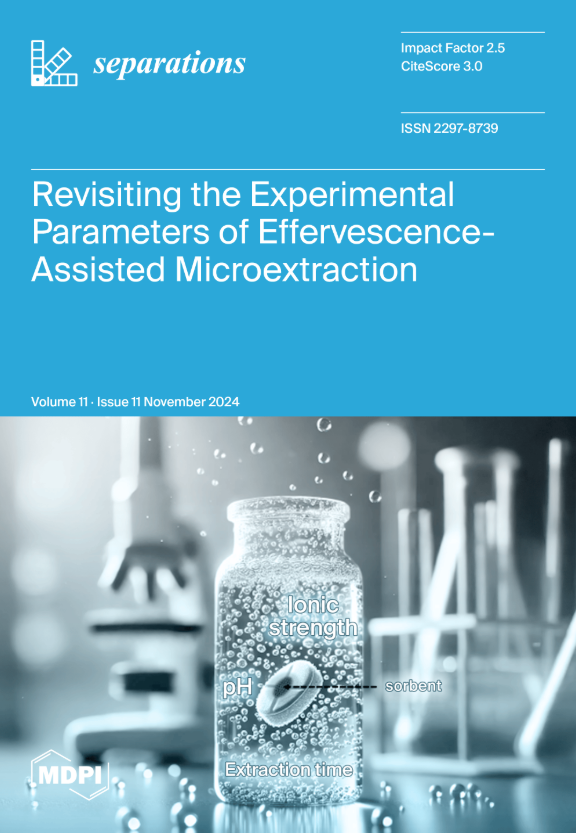The Effect of Paraburkholderia on the Nutrients in Eutrophic Lakes
IF 2.7
4区 工程技术
Q3 CHEMISTRY, ANALYTICAL
引用次数: 0
Abstract
Cyanobacterial blooms in freshwater bodies are mainly attributed to the excess loading of nutrients. The microbes in sediments may affect nutrient migration and transformation during the growth of cyanobacteria. This study focused on the role of Paraburkholderia disturbance in affecting the sediment nutrient conditions and further contributing to cyanobacterial community succession in Meiliang Bay, Lake Taihu. The dissolving phosphorus and fixing nitrogen of Paraburkholderia with different concentration and characteristic capabilities, as well as the impact on nutrients (nitrogen (N), phosphorus (P), iron (Fe), etc.) in eutrophic lakes were determined. The results indicated that the various forms of phosphorus in the sediments showed total phosphorus (TP) > inorganic phosphorus (IP) > iron/aluminum-bound phosphate (NaOH-P) > algal-available phosphorus (AAP) > organic phosphorus (OP) > calcium-bound phosphate (HCl-P). Additionally, it was observed that with higher values of Paraburkholderia (OD600), the higher the corresponding risk of endogenous nutrient release from the sediments into the overlying water (but more is not always better), especially for the solubilization of HCl-P. The diffusion fluxes of TP, total nitrogen (TN) and Fe at the sediment–water interface (SWI) were all positive in the bacteria only experiment, with maximum values of 0.64, 15.0 and 5.02 mg/(m2d), respectively. Additionally, it was interesting that Paraburkholderia were able to produce organic acids, causing a decrease in pH. Furthermore, glucose levels can seriously affect water quality, especially the reduction in dissolved oxygen (DO) (down to 0.01 mg/L), leading to a series of side effects that have a huge impact on cyanobacterial community succession. These results provide a theoretical basis for the microbial ecological factors in eutrophic lakes.副伞菌对富营养化湖泊中营养物质的影响
淡水水体中蓝藻的大量繁殖主要是由于营养物质的过量负荷。沉积物中的微生物可能影响蓝藻生长过程中营养物质的迁移和转化。本文研究了太湖梅梁湾副aburkholderia干扰对沉积物营养条件的影响,进而对蓝藻群落演替的促进作用。测定了不同浓度和特征能力的拟aburkholderia在富营养化湖泊中的溶磷固氮能力,以及对营养物氮(N)、磷(P)、铁(Fe)等的影响。结果表明:沉积物中磷的形态表现为总磷(TP) >无机磷(IP) >铁/铝结合磷(NaOH-P) >藻有效磷(AAP) >有机磷(OP) >钙结合磷(HCl-P)。此外,随着副aburkholderia (OD600)值的增加,沉积物向上覆水体释放内源养分的风险也越大(但并非越多越好),尤其是对HCl-P的增溶作用。细菌实验中TP、TN和Fe在沉积物-水界面(SWI)的扩散通量均为阳性,最大值分别为0.64、15.0和5.02 mg/(m2d)。此外,有趣的是,Paraburkholderia能够产生有机酸,导致ph降低。此外,葡萄糖水平会严重影响水质,特别是溶解氧(DO)的降低(低至0.01 mg/L),导致一系列副作用,对蓝藻群落演替产生巨大影响。这些结果为富营养化湖泊微生物生态因子的研究提供了理论依据。
本文章由计算机程序翻译,如有差异,请以英文原文为准。
求助全文
约1分钟内获得全文
求助全文
来源期刊

Separations
Chemistry-Analytical Chemistry
CiteScore
3.00
自引率
15.40%
发文量
342
审稿时长
12 weeks
期刊介绍:
Separations (formerly Chromatography, ISSN 2227-9075, CODEN: CHROBV) provides an advanced forum for separation and purification science and technology in all areas of chemical, biological and physical science. It publishes reviews, regular research papers and communications. Our aim is to encourage scientists to publish their experimental and theoretical results in as much detail as possible. There is no restriction on the length of the papers. The full experimental details must be provided so that the results can be reproduced. There are, in addition, unique features of this journal:
Manuscripts regarding research proposals and research ideas will be particularly welcomed.
Electronic files and software regarding the full details of the calculation and experimental procedure, if unable to be published in a normal way, can be deposited as supplementary material.
Manuscripts concerning summaries and surveys on research cooperation and projects (that are funded by national governments) to give information for a broad field of users.
The scope of the journal includes but is not limited to:
Theory and methodology (theory of separation methods, sample preparation, instrumental and column developments, new separation methodologies, etc.)
Equipment and techniques, novel hyphenated analytical solutions (significantly extended by their combination with spectroscopic methods and in particular, mass spectrometry)
Novel analysis approaches and applications to solve analytical challenges which utilize chromatographic separations as a key step in the overall solution
Computational modelling of separations for the purpose of fundamental understanding and/or chromatographic optimization
 求助内容:
求助内容: 应助结果提醒方式:
应助结果提醒方式:


